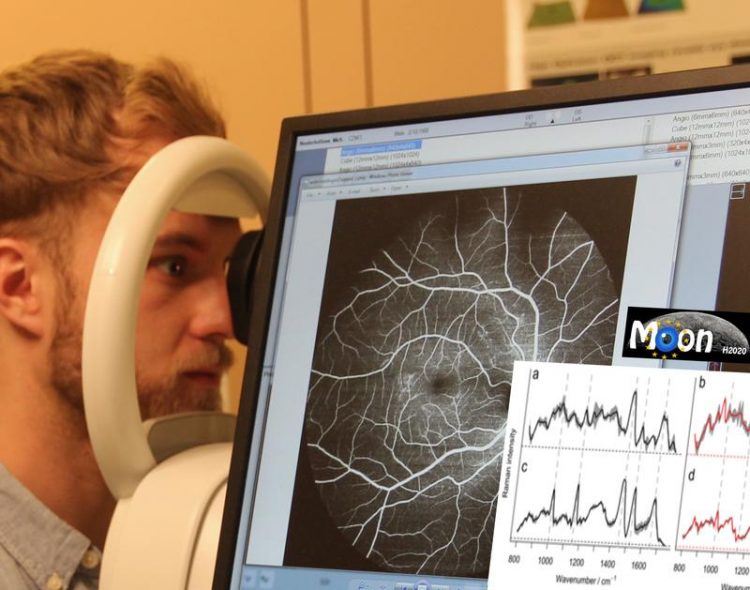Eye scan makes diseases visible at an early stage

The European research team is building a device on which patients can scan their eyes without contact and receive a diagnosis a few minutes later. Ewald Unger/ Medical University of Vienna
A laser beam hits the eye. This sounds more like a risk of injury at first, but in this case it opens up a chance of healing. “We use laser light to obtain comprehensive molecular information about the retina and thus early indications of diseases,” explains Clara Stiebing from Leibniz IPHT.
In order to find out how much laser power the eye can tolerate and which optical pathway the laser takes, the researcher examined retinal samples and designed a structure simulating the conditions in the human eye.
Clara Stiebing and the research team from Leibniz IPHT, Friedrich Schiller University Jena, Medical University Vienna and partners from the Netherlands published their study in the journal “Neurophotonics”.
How intense the laser can be without harming the eye, the scientists have calculated exactly on the basis of applicable safety regulations. The result: a laser beam that is twenty times weaker than the lasers that researchers otherwise use for their spectroscopic measurements.
Using label-free, molecularly sensitive Raman spectroscopy, they are able to obtain a molecular fingerprint of the retina. This reveals how high the content of lipids, proteins, carotenoids and nucleic acids is. In this way, changes in the retina become visible, enabling doctors to detect diseases at an early stage.
A particular challenge for the researchers was that the conditions in the human eye were not optimal for optical measurements. “The fact that we are still able to achieve meaningful, reliable results with the attenuated laser beam clearly shows that our technology will enable us to obtain comprehensive molecular information about the structure of the retina in the future,” said Clara Stiebing.
The partners of the Medical University of Vienna are currently building a device that combines Raman spectroscopy with optical coherence tomography (OCT). With the help of OCT, the morphology of the retina can be very quickly made visible and suspicious areas can be identified. Raman spectroscopy can then be used to characterise these areas at the molecular level.
“This enables us to obtain high-resolution images from all layers of the retina including information on their molecular composition,” explains Prof. Jürgen Popp, scientific director of Leibniz IPHT. “The fact that we can now supplement the OCT previously used in ophthalmology with Raman spectroscopy can significantly improve the accuracy of the diagnoses.“
The European research team is currently working on the medical approval of the device. Once approved, the device can be tested on patients. The patients would then sit in front of the device, have their eye scanned without contact and a few minutes later, they would receive a reliable diagnosis.
The new technologies for the diagnosis of age-related eye diseases and neurodegenerative diseases are being researched by scientists at Leibniz IPHT in Jena together with partners from Austria, France and the Netherlands.
The European Union is funding the MOON project (multimodal optical diagnostics for age-related diseases of the eye and central nervous system) as part of the Horizon2020 program with around 3.7 million euros as an initiative of the Photonics Public-Private-Partnership Photonics21. The research team plans to be able to carry out initial measurements on patients by the end of the project period at the end of 2020.
More information can be found at http://moon2020.meduniwien.ac.at
https://www.spiedigitallibrary.org/journals/neurophotonics/volume-6/issue-04/041…
https://www.leibniz-ipht.de/en/institute/presse/news/detail/augenscan-macht-kran…
Media Contact
All latest news from the category: Medical Engineering
The development of medical equipment, products and technical procedures is characterized by high research and development costs in a variety of fields related to the study of human medicine.
innovations-report provides informative and stimulating reports and articles on topics ranging from imaging processes, cell and tissue techniques, optical techniques, implants, orthopedic aids, clinical and medical office equipment, dialysis systems and x-ray/radiation monitoring devices to endoscopy, ultrasound, surgical techniques, and dental materials.
Newest articles

A universal framework for spatial biology
SpatialData is a freely accessible tool to unify and integrate data from different omics technologies accounting for spatial information, which can provide holistic insights into health and disease. Biological processes…

How complex biological processes arise
A $20 million grant from the U.S. National Science Foundation (NSF) will support the establishment and operation of the National Synthesis Center for Emergence in the Molecular and Cellular Sciences (NCEMS) at…

Airborne single-photon lidar system achieves high-resolution 3D imaging
Compact, low-power system opens doors for photon-efficient drone and satellite-based environmental monitoring and mapping. Researchers have developed a compact and lightweight single-photon airborne lidar system that can acquire high-resolution 3D…





















